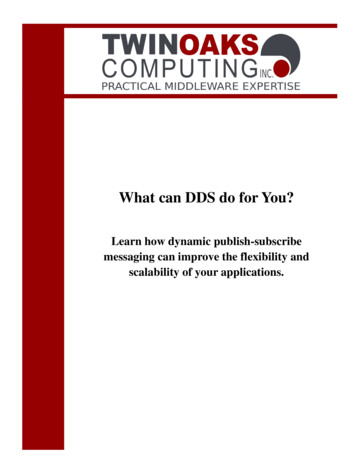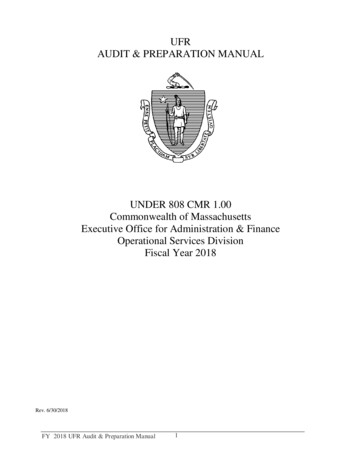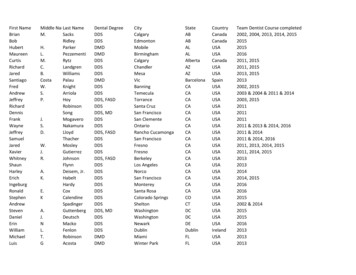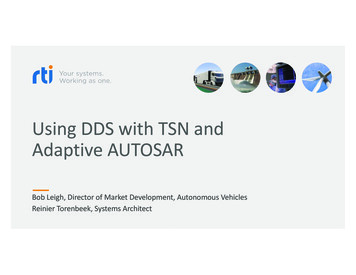
Transcription
What can DDS do for You?Learn how dynamic publish-subscribemessaging can improve the flexibility andscalability of your applications.
2Interoperable DDS StrategiesContents:Abstract 3What does DDS do 3The Strengths of DDS 4DDS Compared to Other Middleware Technologies 8Why is CoreDX DDS different?.11Conclusion 152
3Interoperable DDS StrategiesAbstractThe Data Distribution Service (DDS) technology may not be as well known or understood asother middleware communications technologies like Corba, JMS, Web Services or eventraditional sockets that are key components of nearly all distributed applications. Developerseverywhere are familiar with these conventional data communications solutions, and may becomfortable customizing them to their particular domain and application. However, theflexibility and configurability of DDS makes it a better solution for applications in a wide varietyof industries, from enterprise servers to deeply embedded applications.This paper focuses on the DDS technology in embedded environments and compares it withSockets, Corba, JMS, and SOA Web Services.What does DDS do?DDS, the Data Distribution Service, is a data communications standard managed by the OMG(http://www.omg.org) that describes low-latency data communications for distributedapplications. The DDS standard includes support for Type-Safe application defined data types;Dynamic Discovery of publishers, subscribers, and topics; rich Quality of Service policyconfiguration; and on the wire Interoperability. DDS implementations provide high-performancedata communications, suitable for real-time and near real-time systems. There are currentlyseveral commercial and open source implementations of the DDS standard available for use,including products built for and targeting embedded communications.The DDS Standard contains an easy to use, well defined Application Programming Interface(API). This allows the developer to write portable code, code that will work with any compliantDDS implementation. The DDS standard references the Real Time Publish Subscribe (RTPS)Wire Protocol standard which defines the wire protocol for DDS communications. This allowsapplications built with different DDS implementations to communicate, or interoperate, witheach other. Users of DDS do not tie themselves to a particular vendor, but to a standard, and canchange or intermix DDS vendors throughout the development and deployment cycles.In general, DDS is a peer-to-peer communication model requiring no gateways, servers, ordaemons that must be run or configured.Each application that will communicate over DDS contains the DDS API and provides thediscovery, and other required communication details.Historically, DDS has been used in large DoD systems to satisfy Open Architecture requirementsfor Extensibility, Maintainability, Composability, and Interoperability, but only in the largercomputer components of these systems. Now, with the availability of small-footprint DDSimplementations, many other applications can benefit from standardized publish subscribecommunications. New areas starting to adopt DDS include safety critical applications likeUAVs; renewable energy and smart grid suppliers; and resource constrained environmentswithin the DoD where enterprise DDS solutions were unsuitable.3
4Interoperable DDS StrategiesFigure 1The Strengths of DDSPublish Subscribe ArchitectureDDS provides a flexible publish subscribe architecture. A publish subscribe architecturepromotes a loose coupling between data architecture is flexible and dynamic; it is easy to adaptand extend DDS based systems to changing environments and requirements. The followingfigure illustrates the DDS Publish Subscribe architecture where multiple Publishers andSubscribers exchange strongly typed data through a common Topic. The communications arecontrolled by a robust Quality of Service model.An application may be a publisher of data, a subscriber of data, or both a publisher andsubscriber. An application may participate in multiple Domains and include multiple publishersand subscribers. Figure 2 is an example of how DDS might be applied in a system. Thisexample has several sources of “raw data”, a data processor that performs some processing onthe raw data to produce “processed data”, several end users working with the processed data, andan administrative user performing analysis, maintenance, or auditing functions.In this example, the darker blue boxes represent applications communicating over a DDSnetwork. These applications might be running together on 1 host, or they might be distributedover multiple hosts. A DDS application simply publishes or subscribes to data, without concernfor what, if anything, might be on the other end of its communications.4
5Interoperable DDS StrategiesFigure 2DiscoveryDDS provides Dynamic Discovery of publishers and subscribers. Dynamic Discovery makesyour DDS applications extensible. This means the application does not have to know orconfigure the endpoints for communications because they are automatically discovered by DDS.This dynamic discovery goes even further than discovering endpoints. DDS will discover if theendpoint is publishing data, subscribing to data, or both. It will discover the type of data beingpublished or subscribed to. It will also discover the publisher’s offered communicationcharacteristics and the subscriber’s requested communications characteristics. All of theseattributes are taken into consideration during the dynamic discovery and matching of DDSparticipants.DDS participants can be on the same machine or across a network: the application uses the sameDDS API for communications. Because there is no need to know or configure IP addresses, ortake into account the differences in machine architectures, adding an additional communicationparticipant on any operating system or hardwareplatform becomes an easy, almost trivial, task.Strong Type SafetyDDS provides strong type safety by requiring the application to specify the types of data used forcommunications. The application then reads and writes typed data. For example, a Capplication will call write() with a specific structure type, not a void pointer./* Declare a variable with an application-defined data type */StringMsg myStringMsg;/* Call write() with the typed variable, no casting necessary */StringMsgDataWriter write ( dw, &myStringMsg, DDS HANDLE NIL );5
6Interoperable DDS StrategiesThis allows for more errors to be caught early in the development cycle, reducing developmentcosts.The application defines the data types that will be used for communications using a platformindependent language. DDS implementations provide a tool to compile this data type definitioninto a natural, programming language specific, data type. Thispublishing data and subscribing to data over the DDS network.QoS PoliciesDDS provides a rich set of Quality of Service (QoS) policies to tailor the behavior ofcommunications. These QoS policies can be used individually or together to affect a variety ofcommunications aspects, including reliability, performance, persistence of data, and amount ofsystem resources used. These QoS policies set DDS apart from all other communicationmiddleware solutions. The breadth and depth of the configuration available with these QoSpolicies allow DDS to be a superior choice for communications in a large variety of industriesand architectures.InteroperabilityDDS Interoperability is the ability of DDS implementations from different vendors tocommunicate. The Real-Time Publish Subscribe (RTPS) protocol defines the standardized wireprotocol for DDS and is what allows interoperability on the wire between differentimplementations of DDS.Architects and system designers in charge of large software systems understand the importanceof interoperability, and how difficult it is to obtain. Each DDS implementation offers its ownstrengths and advantages. Large software systems contain many subsystems and components,and frequently, each of these parts has different networking requirements. When you are writingyour own communications software, you can customize it to meet the requirements of eachsubsystem. Until now, this has not been possible with commercial communication middlewareproducts. However, with today’s interoperable DDS implementations, system architects have theflexibility they require to select the DDS vendor that best meets the requirements of each part oftheir system, and will maintain a flexible, interoperable architecture.6
7Interoperable DDS StrategiesNot all DDS implementations are interoperable. There are currently three vendors active ininteroperability testing and demonstration: Twin Oaks Computing, RTI, and PrismTech. Thesevendors are active at the OMG Technical Meetings and regularly test and demonstrate theirinteroperable DDS products. [ tm ]PerformanceDDS is a low-latency communication architecture, and while different implementations of DDSwill have different performance characteristics, in general all implementations will be highperformance. This is because the DDS and RTPS specifications are written to satisfy therequirements of real-time and near real-time systems.These specifications contain instructions to keep data copies to a minimum within the DDSmiddleware. They also specify a compact data encoding on the wire, light-weight notificationmechanisms, and the ability for the application to specify resources limits: allowing DDS to preallocate memory and reduce the number of memory allocations during run-time. All of thesecharacteristics result in DDS implementations that are in general efficient, low-overhead, andhigh-performance.7
8Interoperable DDS StrategiesDDS Compared to Other Middleware TechnologiesDDS vs. Sockets APIThe Sockets API has been around for decades, and it continues to be used in virtually allindustries requiring data communications. Many developers consider the Sockets API to be theclear choice to meet strict performance requirements or to perform communications onspecialized hardware and operating systems. Especially in embedded environments, many othercommunication middleware technologies simply do not fit. With very constrained memory anddisk resources, and often with specialized processors and networking hardware, writingcustomized code using sockets has been the preferred solution to embedded communications.DDS provides low-latency, high-throughput data communications, similar to the performancethat can be achieved with raw Sockets. And, with small footprint DDS implementations, DDScan not only run in resource constrained environments, it can also be easily ported to run on anduse custom hardware and operating systems.The architecture between the TCP Sockets API and DDS is fundamentally different: TCPSockets are connection oriented, a point-to-point, client-server architecture. This requires thatclients and servers know each other’s location in order to connect. This is vastly different fromthe publish-subscribe architecture of DDS.With DDS, the development of distributed applications is simplified. DDS provides a commonAPI regardless of operating system or hardware architecture. DDS handles the discovery andmanagement of remote endpoints. DDS handles the details of communication behaviors likefiltering, reliability, durability, saving historical data, detecting deadline misses and changes inliveliness, and many more. These are all features that do not need to be coded, they are accessedthrough the standard DDS API. This leaves you more time to focus on the functionalrequirements of your applications.8
9Interoperable DDS StrategiesThe above table summarizes the similarities and differences between DDS and CORBADDS vs. CORBAThe CORBA and DDS technologies share the same roots as an open standard managed by theOMG. Probably because of this, there are some similarities, especially in the strong type safetyprovided by both technologies. Although both technologies contain standards for aninteroperable wire protocol, DDS vendors have shown a unique cooperation in testing anddemonstrating inter-product interoperability.CORBA is another client-server middleware, based on remote procedure calls, or “remoteinvocations” in CORBA terminology. CORBA provides a layer of abstraction using an ObjectRequest Broker (ORB) to manage the connections. Clients and Servers need to know about eachother directly or use a Naming Service.9
Interoperable DDS StrategiesThe abovetable summarizes the similarities and differences between DDS and JMS.DDSvs. JMSThe Java Messaging Service (JMS) and DDS are both publish-subscribe middlewaretechnologies. This provides some common ground for comparing the two technologies, but thereare also some significant differences.JMS uses a server for communications that must be configured with the queues or topics that willbe used. While publishers and subscribers themselves are loosely coupled, each applicationparticipating in JMS communications must connect to a JMS server. The JMS server handles thedetails of connecting publishers and subscribers. In contrast, DDS does not require any serversor daemons: DDS handles discovery and management of endpoints in each DDS application.Using DDS eliminates the need for a server, and thus the potential single point of failure, andreduces the complexity of the deployed network.DDS offers some significant benefits that are not available from JMS offerings, including thedynamic discovery of endpoints, no server or daemon process required; the ability to tailorcommunication behaviors of individual Data Readers and Data Writers through Quality ofService policies; advanced time and content based filtering; and proven interoperability betweendifferent vendor implementations.DDS vs. Service Oriented Architecture (SOA)Service Oriented Architecture is an architectural style implemented by many technologies suchas WS (Web Services), JMS, CORBA, and DDS. DDS distinguishes itself from other SOApublish-subscribe technologies such as JMS and WS Notification by its robust Quality of Servicepolicies including complex time and content based filters. DDS allows application developers toconfigure the urgency, importance, reliability, and persistence of each piece of data to becommunicated. DDS makes an excellent interoperable publish subscribe SOA component.1010
Interoperable DDS StrategiesWhy is CoreDX DDS different?CoreDX DDS, an implementation of the DDS and RTPS standards, provides a number ofsignificant technical benefits over leading commercial and open source DDS implementations.Small FootprintCoreDX DDS is a full-featured DDS implementation that comes in a surprisingly small package.The entire ‘C’ library, containing full interoperability with the RTPS wire protocol and supportfor all the standard, and a some additional QoS policies, is a mere 500 KB. That’s Kilobytes, notMegabytes! Our CoreDX DDS Ping application (text-based application built to testinteroperability over lots of QoS policies) is 250 KB.While CoreDX DDS can run on enterprise-class servers, it does not require expensive computeplatforms. CoreDX DDS makes a DDS application run on standard, Intel-based desktops andlaptops, Single Board Computers (SBCs) with Intel or PPC processors, and even smaller formfactor computers using ARM processors. Applications built with the standard CoreDX DDSproduct can run on machines with less than 640 KB of memory.Advanced Multicore SupportWith the growing prevalence of multi-core computer systems,software architects are presented with many opportunities forperformance improvements; however, parallel-programmingenvironments raise significant complexity challenges.Programming languages and Operating Systems provide some1111
Interoperable DDS Strategiestools to help reduce the complexity of parallel programming; but these fundamental tools arecomplex in themselves.The CoreDX DDS middleware simplifies the task of putting additional cores to work. Theengineers at Twin Oaks Computing have worked with multi-threaded and parallel programmingenvironments for over a decade. This expertise has been incorporated into the advanced datapipeline architecture in CoreDX DDS . By internally pipelining the flow of data, CoreDXDDS can employ multiple processing cores simultaneously. This automatic distribution ofwork across multiple cores is easy to exploit in application code because of the flexibility of theCoreDX DDS API.With these tools, developers can write application software with a single thread of control, andthe CoreDX DDS middleware will distribute the communications work across multiple cores.This simplifies the application code while employing sophisticated parallel programmingtechnologies.Low Line of Code CountThe number of software lines of code (SLOC) in a software product is not something everycustomer considers. Of course, SLOC counts are important to systems with safety criticalrequirements. These systems must certify each line of code, and 3rd party software packages likecommunication middleware are not exempt from this certification process. This adds anadditional cost to every line of code in the system. However, SLOC counts also haveimplications outside of the safety critical markets.Every line of code in a software product has a cost associated with it, and not just the cost ofcertification for safety critical applications. Twin Oaks Computing not only understands this;this idea is the foundation for our software development processes. Each line of code developedfor CoreDX DDS must be tested and maintained over the life of our product. Larger softwarebaselines will have greater test and maintenance expenses. Each line of code has the potentialfor increasing the number of instructions that must be executed, and degrading the overallperformance of communications. In addition, each line of code has the potential for aprogramming error, or bug, and more lines of code make it difficult to track down and identifysuch errors.These are fundamental concepts in any software development project, and truly experiencedsoftware engineers understand the importance of writing code that is well thought out andcompact. Every engineer at Twin Oaks Computing understands these concepts and follows aspecific software process for making changes to the CoreDX DDS baseline. Each softwareaddition and modification is carefully analyzed for its SLOC and performance impact and benefitto the overall product. If we are not happy with the end result, we go back to the drawing boardfor another solution. These fundamental software engineering concepts and complementingprocesses ensure the CoreDX DDS baseline maintains it status as the World Leading SmallFootprint DDS Implementation.The complete CoreDX DDS baseline includes fewer than 35,000 SLOC for the Standard Edition.Twin Oaks Computing also has a Safety Critical Baseline for the CoreDX DDS product, which1212
Interoperable DDS Strategieshas fewer than 13,000 SLOC. This new Safety Critical Baseline includes all the QoS policiesand features of the standard CoreDX DDS baseline. In fact, the real difference between the twobaselines is the discovery process: the Safety Critical Baseline contains a modified (lessdynamic) discovery process.PerformanceThe performance of most DDS implementations will be good – very good when compared withJMS and other XML-based communication middleware technologies. The performance ofCoreDX DDS goes further. For example, on a 1Gb network, CoreDX DDS can providethroughputs over 900 Mbps, and latencies around 60 microseconds.The performance that can be achieved with any communication middleware is going to dependon the network and machine configurations: the switch hardware, network interface card (NIC),operating system, and network device driver all impact the baseline throughput and latencies thatcan be achieved on a system.The application developer has control over the performance achieved by adjusting how CoreDXDDS is configured and used.1313
Interoperable DDS Strategies1414
Interoperable DDS StrategiesCoreDX DDS provides a number of configuration options that will affect the performance of thesystem. First, the data types employed will affect performance. In general, data types that resultin smaller message sizes will provide lower latencies, while data types that result in largermessage sizes will provide better throughput. In addition, many DDS QoS policies will affectperformance, including Reliability, History, Resource Limits, Latency Budget, and Durability.In general, the best performance can be achieved by setting Resource Limits and using data typesthat are fixed sizes (allowing CoreDX DDS to reduce the amount of memory allocationperformed during operations by pre-allocating the necessary resources). In addition, throughputcan be improved by using larger message sizes and longer Latency Budgets. By contrast, latencyresults can be optimized by using smaller message sizes and no Latency Budgets.Dynamic TypesA feature exclusive to CoreDX DDS is support for Dynamic Type Technology. This innovativenew technology eases system integration challenges, and enables bridging DDS data betweendisparate systems in a flexible and dynamic environment. This technology enables DataReadersto dynamically, at run-time, determine the topic data types. Through Dynamic Typeintrospection, the subscribing application can explore the data type and access data fields.Dynamic Type Technology is a critical component for the deployment of useful DDS bridgingsolutions. Without this technology, DDS bridges must be maintained and upgraded in lock-stepwith the systems they support. Dynamic Types offer a flexible solution that lowers Total Cost ofOwnership.ConclusionUsing DDS for data communications between distributed applications provides a number ofbenefits over other traditional data communication solutions. Benefits of DDS include DynamicDiscovery, strong Type Safety, a wide variety of configuration options in the QoS policies,Interoperability, and Performance.While the DDS technology has been available for nearly two decades, until recently theseimplementations required resources not available to embedded application designers. Today, allthe benefits of DDS are available in a significantly smaller footprint, the perfect solution for notonly embedded environments, but also safety critical applications that must certify every line ofcode.1515
Interoperable DDS StrategiesAbout Twin Oaks ComputingWith corporate headquarters located in Castle Rock,Colorado, USA, Twin Oaks Computing is a companydedicated to developing and delivering qualitysoftware solutions. We leverage our technicalexperience and abilities to provide innovative anduseful services in the domain of datacommunications. Founded in 2005, Twin OaksComputing, Inc delivered the first version of CoreDXDDS in 2008. The next two years saw deliveries toover 100 customers around the world. We continueto provide world class support to these customerswhile ever expanding.ContactTwin Oaks Computing, Inc.(720) 733-7906 33 (0)9 62 23 72 20755 Maleta LaneSuite 203Castle Rock, CO. 80108www.twinoakscomputing.comCopyright 2011 Twin Oaks Computing, Inc. Allrights reserved. Twin Oaks Computing, the Twin OaksComputing and CoreDX DDS Logos, are trademarksor registered trademarks of Twin Oaks Computing,Inc. or its affiliates in the U.S. and other countries.Other names may be trademarks of their respective 16owners. Printed in the USA. 12/201116
independent language. DDS implementations provide a tool to compile this data type definition into a natural, programming language specific, data type. This publishing data and subscribing to data over the DDS network. QoS Policies DDS provides a rich set of Quality of Service (QoS) policies to tailor the behavior of communications.











